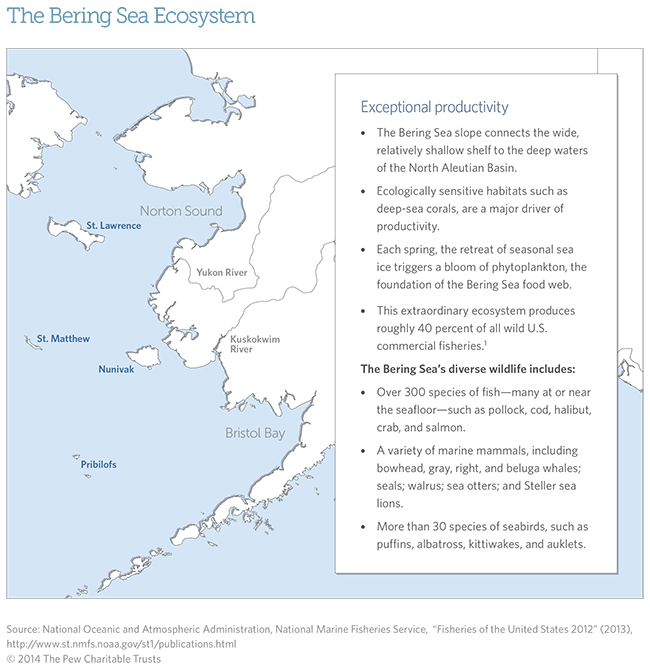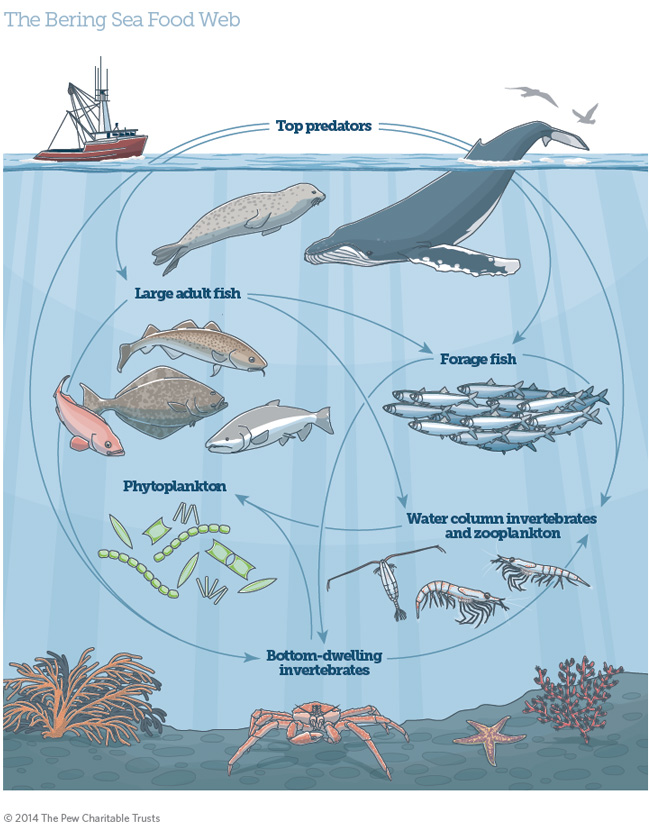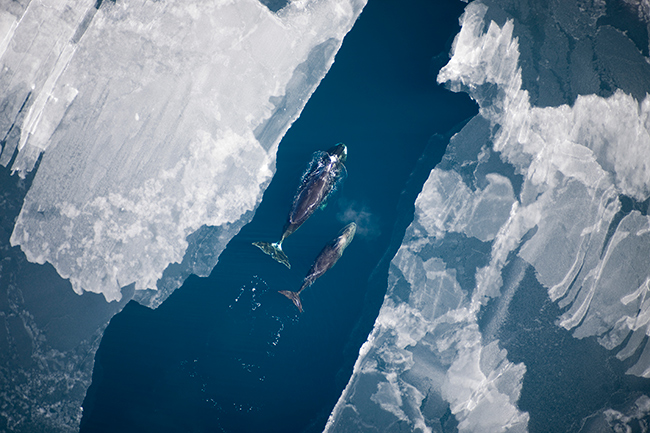Ecosystem-based Fishery Management in the Bering Sea
Planning for a healthy ecosystem
The U.S. and some other nations have recently made efforts to bring fishing to sustainable levels, as defined by conventional fisheries science.
In the Bering Sea, science-based management of major fisheries is designed to control fishing at levels that maintain stable populations of valuable fish. But a single-species approach to managing fisheries does not always consider the interconnections among marine organisms. Many scientists argue that although good single-species management is necessary, fishery managers also need to look at the bigger picture.
Ecosystem-based fisheries management is a way to sustain the health of our oceans by accounting for the interconnections among marine life, an ever-changing environment, and human activities including commercial, recreational, and subsistence fishing. Tools and approaches to aid in ecosystem-based fisheries management are available to reduce bycatch; conserve important habitat; protect marine food webs; monitor ecosystem health; and evaluate the ecological, social, and economic trade-offs of different management actions.
In the Bering Sea, many of these tools are being applied. Yet more will be needed to steward this ecosystem in the years ahead. As our knowledge of the Bering Sea ecosystem grows, as demand for seafood increases, and as impacts of climate change are felt, fishery managers must put a long-term plan in place to address the challenges the future will bring.

The Bering Sea, home to a diverse array of marine life as well as the largest fisheries in the United States, is one of the most productive marine ecosystems in the world. The region is also home to indigenous Alaskans, who have been a part of the ecosystem for millennia and have traditional knowledge gained from their subsistence way of life.
Because it is so important ecologically, economically, and culturally, the Bering Sea is a highly studied ecosystem. Much of the current governmental, academic, and private research on the area is geared toward understanding what drives fish productivity, and identifying and adapting to the impacts of global climate change on the region. This wealth of knowledge provides the foundation for implementing an ecosystem-based approach to managing fisheries in the Bering Sea.
What are some of the ecosystem issues facing fishery managers in the North Pacific?
The North Pacific Fishery Management Council is a global leader in sustainable fishery management and has a history of establishing proactive and precautionary measures to protect marine life and sustain fish resources. The council’s previous actions include protecting forage species, setting aside over 520,000 square nautical miles of ecologically important habitat, and reducing catch limits to avoid overfishing. Yet as the demands on our oceans grow and the impacts of climate change become increasingly evident, fishery managers must remain vigilant in their efforts to protect the broader marine ecosystem. In the North Pacific, the council has an opportunity to safeguard and enhance marine ecosystems in the Gulf of Alaska, the Aleutian Islands, the Bering Sea, and the Arctic as it faces at least four challenges:
Bycatch—The unintended catch of non-target species in the groundfish fishery has led to industry and council action to avoid bycatch “hot spots,” establish enforceable limits, and develop gear modifications designed to reduce bycatch. Moving forward, the council will need a long-term plan to minimize incidental catch of salmon and halibut, which are critical to commercial and subsistence fisheries, and to monitor and minimize bycatch of other species that are important to the ecosystem.
Habitat protection—Recent scientific information showing concentrations of deep-sea corals and other ecologically important and sensitive habitats along the Bering Sea slope has led the council to consider measures to protect these habitats from the harmful impacts of damaging fishing gear such as bottom trawls.
Climate change—Climate change and related phenomena such as ocean acidification will alter the Bering Sea ecosystem and have significant consequences for all who depend on it, from krill to coastal communities. Reductions in sea ice, for example, can affect the seasonal bloom of plankton and reduce the productivity of the overall ecosystem. Understanding and predicting these changes enables decision-makers to adapt fisheries management in order to mitigate and protect against the harmful impacts of climate change in the North Pacific.
Food web dynamics—Data collection and ecosystem modeling are providing greater understanding of important predator-prey relationships in the Bering Sea ecosystem. For example, new models are available to monitor and react to changes in the availability of forage species such as krill. As knowledge of these relationships grows, fisheries can be better managed to maintain the structure and function of this dynamic and productive ecosystem.

What is a fishery ecosystem plan?
A fishery ecosystem plan (FEP) provides a science-based road map for regional fishery councils to implement ecosystem-based management. Specifically, an FEP should guide and facilitate the incorporation of ecosystem science into the fishery management process by generating and disseminating information on how our fisheries affect—and are affected by—the broader ecosystem. Information produced through an FEP should lead to fishery management actions that help promote both sustainable fishing and healthy ocean ecosystems.
Why develop a Bering Sea FEP?
A Bering Sea FEP would enable the North Pacific Fishery Management Council to better approach broader ecosystem issues that are not directly addressed through its existing species-based fishery management plans for groundfish, crab, scallops, and salmon. By synthesizing ecosystem science and information in a way that is helpful to fishery managers, an FEP would help the council make informed decisions that sustain this productive ecosystem. For example, an FEP could help develop measures to protect food web structure and function, thereby ensuring a healthy prey base for all components of the ecosystem. Or, by considering what drives fishery productivity in the Bering Sea, an FEP could provide a management framework for adapting to the impacts of climate change.
In addition to providing guidance for specific management actions, an FEP also would add value to the council’s public decision-making process by communicating its broader ecosystem goals and objectives, and providing a mechanism for assessing whether it is meeting them. By monitoring ecosystem indicators and analyzing potential management actions, the council would be able to use the FEP to forecast ecosystem trends and identify future research and data needs.
Ultimately, the FEP would provide a transparent framework to analyze the ecological, social, and economic tradeoffs between alternative policies and management actions. Such a framework would enable council members to account for the direct and cumulative impacts of their decisions in order to protect the Bering Sea ecosystem and maintain productive and sustainable fisheries.
 © 2009 National Geographic
© 2009 National GeographicWestern Arctic bowhead whales spend fall and winter in the Bering Sea, having returned from their annual migration through the Chukchi and Beaufort Seas in spring and summer. They prey on zooplankton and water column invertebrates.
What should be in a Bering Sea FEP?
Essential components of a Bering Sea FEP include:
- The council’s ecosystem goals and objectives: These will help communicate the council’s management priorities for the Bering Sea ecosystem and provide metrics by which to evaluate success.
- A description of the ecosystem: An overview of the Bering Sea ecosystem will give stakeholders information on its structure and function, including fisheries, fishing communities, and the traditional knowledge of its indigenous peoples. This overview should also help communicate current understanding of how fisheries affect, and are affected by, the Bering Sea ecosystem.
- Indicators of ecosystem status and health: An essential function of the FEP will be to create a plan to establish and monitor indicators that correspond to the council’s goals and objectives for the ecosystem. By illustrating and forecasting biological, social, and economic trends, ecosystem indicators will help improve the fisheries management process.
- Evaluation and assessment: The FEP should provide a mechanism to evaluate the council’s strategy for managing fisheries to help ensure that ecosystem goals and objectives are achieved, and a plan for adjusting strategies as needed to improve progress.
- Conservation and management measures: While FEPs are only advisory, they should provide information and guidance to help the council enact ecosystem-based measures through existing fishery management plans.
Why does this matter, and what can you do?
Everyone involved in federal fisheries management in the North Pacific— including fishermen, seafood processors, environmental organizations, and subsistence communities—has a stake in ensuring healthy and productive ecosystems for future generations. As the global population increases, so too will the demands on our oceans to provide food. And as the effects of climate change are seen firsthand in the Arctic and around the world, we must take proactive, precautionary action to ensure that we are managing our marine resources sustainably and with an eye toward the future. FEPs can help fishery managers lead this new way of thinking.











